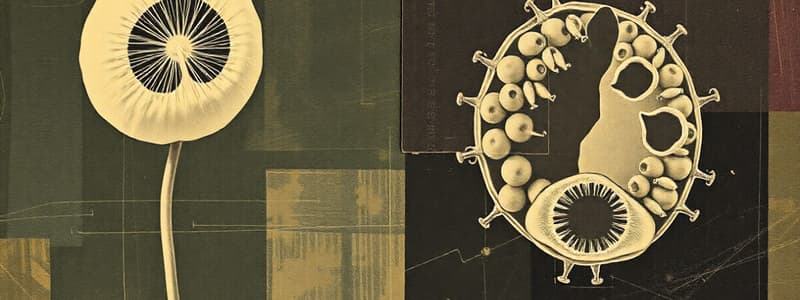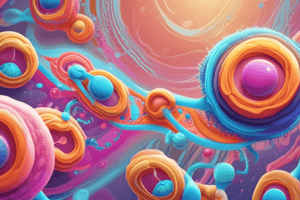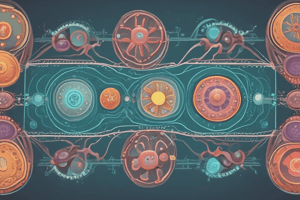Podcast
Questions and Answers
What is the outcome of meiosis?
What is the outcome of meiosis?
Four genetically different daughter cells
How many chromosomes do human gametes have?
How many chromosomes do human gametes have?
- 46
- 22
- 23 (correct)
- 44
What is the new cell formed at fertilization called?
What is the new cell formed at fertilization called?
- Embryo
- Gamete
- Chromosome
- Zygote (correct)
Meiosis produces genetically identical daughter cells.
Meiosis produces genetically identical daughter cells.
What process occurs in body cells?
What process occurs in body cells?
Match the DNA components and their description:
Match the DNA components and their description:
DNA is organized into structures called ______.
DNA is organized into structures called ______.
What is a common advantage of sexual reproduction?
What is a common advantage of sexual reproduction?
What type of reproduction involves only one parent?
What type of reproduction involves only one parent?
What is the human genome?
What is the human genome?
What type of cells are produced by meiosis?
What type of cells are produced by meiosis?
What occurs during fertilization?
What occurs during fertilization?
Mitosis produces four daughter cells.
Mitosis produces four daughter cells.
How many sets of chromosomes does a zygote have?
How many sets of chromosomes does a zygote have?
Match the following terms with their definitions:
Match the following terms with their definitions:
DNA is made up of four different repeating _____ units.
DNA is made up of four different repeating _____ units.
Mitosis occurs in reproductive organs.
Mitosis occurs in reproductive organs.
What is the main advantage of sexual reproduction?
What is the main advantage of sexual reproduction?
Flashcards
Meiosis
Meiosis
A type of cell division that produces four genetically different haploid daughter cells from a diploid parent cell.
Fertilization
Fertilization
The fusion of a male and female gamete (sex cell) to form a zygote.
Mitosis
Mitosis
A type of cell division resulting in two identical daughter cells, with the same genetic makeup as the parent cell.
Haploid cell
Haploid cell
Signup and view all the flashcards
Diploid cell
Diploid cell
Signup and view all the flashcards
DNA
DNA
Signup and view all the flashcards
Genome
Genome
Signup and view all the flashcards
Nucleotide
Nucleotide
Signup and view all the flashcards
Chromosome
Chromosome
Signup and view all the flashcards
Gene
Gene
Signup and view all the flashcards
Sexual Reproduction
Sexual Reproduction
Signup and view all the flashcards
Asexual Reproduction
Asexual Reproduction
Signup and view all the flashcards
Gamete
Gamete
Signup and view all the flashcards
Zygote
Zygote
Signup and view all the flashcards
Human Migration
Human Migration
Signup and view all the flashcards
Study Notes
Meiosis
- Meiosis produces four genetically different daughter cells from a diploid parent cell.
- The parent cell replicates its chromosomes before division.
- Each daughter cell receives one chromosome from each pair, resulting in haploid cells.
- All daughter cells are called 'daughter cells,' regardless of their eventual fate (sperm cells, etc).
Fertilization
- A male gamete fuses with a female gamete to form a zygote.
- Zygotes are diploid, inheriting one set of chromosomes from each gamete.
- The zygote divides repeatedly by mitosis, forming an embryo.
- The embryo's cells differentiate and increase in number during development.
- Sexual reproduction introduces variation into offspring.
Comparing Mitosis and Meiosis
- Meiosis produces four daughter cells, while mitosis produces only two.
- Daughter cells produced by meiosis are genetically diverse, while those produced by mitosis are identical to the parent cell and each other.
Comparing Haploid and Diploid cells
- Meiosis, occurring in reproductive organs, produces haploid gametes.
- Mitosis, taking place in body cells, produces diploid cells.
DNA and the Genome
- DNA is genetic material found in the nucleus of most cells.
- An organism's entire genetic material constitutes its genome.
DNA Structure
- Chromosomes in the nucleus hold tightly coiled DNA.
- Genes, segments of DNA within chromosomes, code for proteins.
- DNA is a double helix polymer composed of two strands.
DNA Components
- DNA is made up of four different repeating nucleotide units.
- Each nucleotide consists of a phosphate group, a sugar, and a base.
- DNA strands have alternating phosphate and sugar components.
- The four bases in DNA are cytosine (C), guanine (G), thymine (T), and adenine (A).
- Complementary DNA strands pair specific bases: C with G and T with A.
- Three-base sequences within DNA code for specific amino acids.
- The order of bases dictates the order of amino acids in protein synthesis.
The Human Genome
- The complete human genome has been sequenced.
- This information facilitates:
- Identifying genes linked to diseases, aiding in risk assessment.
- Developing novel approaches to treat inherited disorders.
Human Migration
- Certain segments of human DNA remain unchanged across generations.
- Scientists analyze these "markers" in global populations to map human migration patterns.
- Mitochondrial DNA, inherited maternally, and the paternal Y chromosome are used for lineage analysis.
Sexual and Asexual Reproduction
- New individuals can arise through sexual or asexual reproduction.
Features of Sexual and Asexual Reproduction
- Sexual Reproduction:
- Involves two parents.
- Meiosis occurs.
- Gametes fuse.
- Genetic mixing occurs.
- Offspring are not identical.
- Asexual Reproduction:
- Involves one parent.
- Meiosis does not occur.
- Gametes do not fuse.
- No genetic mixing occurs.
- Offspring are identical.
Advantages and Disadvantages of Sexual Reproduction
- Advantages:
- Offspring variation provides survival advantage through natural selection.
- Selective breeding allows for increased food production.
- Disadvantages:
- Finding a mate takes time and energy.
Meiosis
- Meiosis takes place in reproductive organs to form gametes.
- Each daughter cell receives a copy of one chromosome from each pair.
- Through the process of division, the parent diploid cell produces four genetically different haploid daughter cells.
- The haploid cells are called gametes, and have one set of chromosomes.
Fertilization
- A male gamete joins with a female gamete to form a zygote.
- The zygote is diploid, containing two sets of chromosomes.
- The zygote divides repeatedly by mitosis to develop an embryo.
- Sexual reproduction introduces variation in offspring.
Comparing Mitosis and Meiosis
- Meiosis produces four daughter cells, while mitosis produces two.
- Meiosis produces genetically different daughter cells, while the daughter cells are genetically identical in mitosis.
DNA and the Genome
- The genetic material of an organism is called the genome.
- The nucleus of most cells contains chromosomes.
- DNA is a tightly coiled polymer composed of two strands forming a double helix.
- A gene is a segment of DNA that codes for a specific protein.
DNA Structure
- A nucleotide is a unit of DNA, made up of a phosphate group, a sugar, and a base.
- The bases are cytosine (C), guanine (G), thymine (T), and adenine (A).
- The sequence of bases determines the order of amino acids in a protein, and therefore the protein's function.
The Human Genome
- Genetic studies can help detect genes related to diseases like cardiovascular disease and cancer.
- This knowledge can help identify individuals at higher risk and develop new treatment strategies for inherited disorders like cystic fibrosis.
Human Migration
- 'Marker' segments of DNA remain unchanged over generations.
- Scientists use these markers to trace human migration patterns.
- Mitochondrial DNA is inherited from the mother, while the Y chromosome is inherited from the father.
Sexual and Asexual Reproduction
- Sexual reproduction involves two parents and results in offspring with genetic variation.
- Asexual reproduction involves one parent and produces identical offspring.
- Sexual reproduction produces variation, increasing the survival chances of offspring.
- Asexual reproduction can be used to increase food production through selective breeding.
- Disadvantages of sexual reproduction includes finding a mate and the time/energy required.
Studying That Suits You
Use AI to generate personalized quizzes and flashcards to suit your learning preferences.
Description
Test your knowledge on meiosis, fertilization, and the differences between mitosis and meiosis. Explore how these processes contribute to sexual reproduction and genetic diversity. This quiz will help reinforce your understanding of cell division and development.




